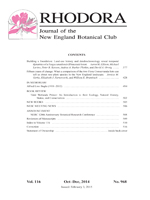We used historical documents, stand mapping, and new methods of dendrochronological analysis to reconstruct 250 y of land-use history of the Simes Tract in Petersham, MA. These data were then used to interpret the origin of the current forest's stand structure within the experimental plots of the Harvard Forest Hemlock Removal Experiment within the Simes Tract, an experiment that examines the effects of the ongoing decline of Tsuga canadensis on forest ecology. Data from tree cores revealed that the trees in the experimental plots were < 150 y old. These trees have established continually since the 1870s, with recruitment pulses following successive episodes of land division and re-aggregation, logging, irruptions of nonnative insects and pathogens, two moderate droughts, and the 1938 “Great Hurricane”. Our new method of dendrochronological analysis used generalized additive models and focused on year-to-year dynamics to highlight associations between fine-scale changes in tree growth, and both episodic (pulse) and longer-term environmental and biotic drivers. Tsuga canadensis, hypothesized to be a foundation species in this system, achieved its current dominance at the Simes Tract by responding rapidly, both positively and uniformly across age classes, in the 1920s to three concomitant environmental changes that had occurred in the preceding two decades: loss of Castanea dentata to the chestnut blight; selective logging; and a ∼ 7 y drought. In contrast, Betula lenta, Quercus rubra, Acer rubrum, and Pinus strobus have declined in importance since the early 1900s in stands otherwise dominated by T. canadensis. Acer rubrum and P. strobus were selectively harvested or severely damaged by the 1938 hurricane, the peak of B. lenta establishment followed the 1938 hurricane, and Q. rubra growth was impacted by the severe 1981 gypsy moth outbreak. Together, the data illustrate the contingent nature of the establishment dynamics of a foundation species in a New England forest and suggest a more nuanced approach to the role of T. canadensis as a foundation species.
How to translate text using browser tools
22 December 2014
Building a foundation: Land-use history and dendrochronology reveal temporal dynamics of a Tsuga canadensis (Pinaceae) forest
Aaron M. Ellison,
Michael Lavine,
Peter B. Kerson,
Audrey A. Barker Plotkin,
David A. Orwig
ACCESS THE FULL ARTICLE

Rhodora
Vol. 116 • No. 968
October 2014
Vol. 116 • No. 968
October 2014
dendrochronology
foundation species
general additive model
Harvard Forest
land-use history
Massachusetts
Tsuga canadensis




